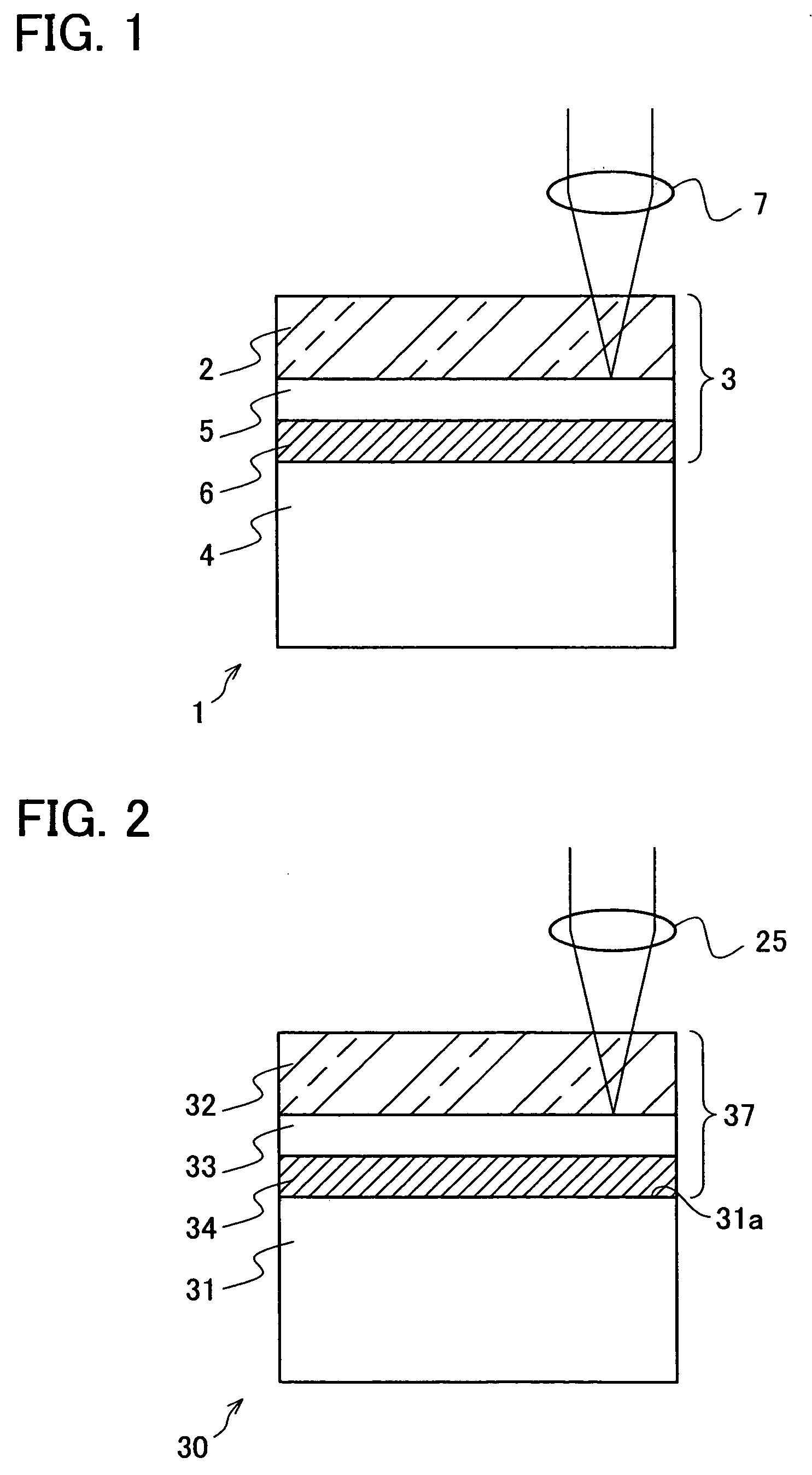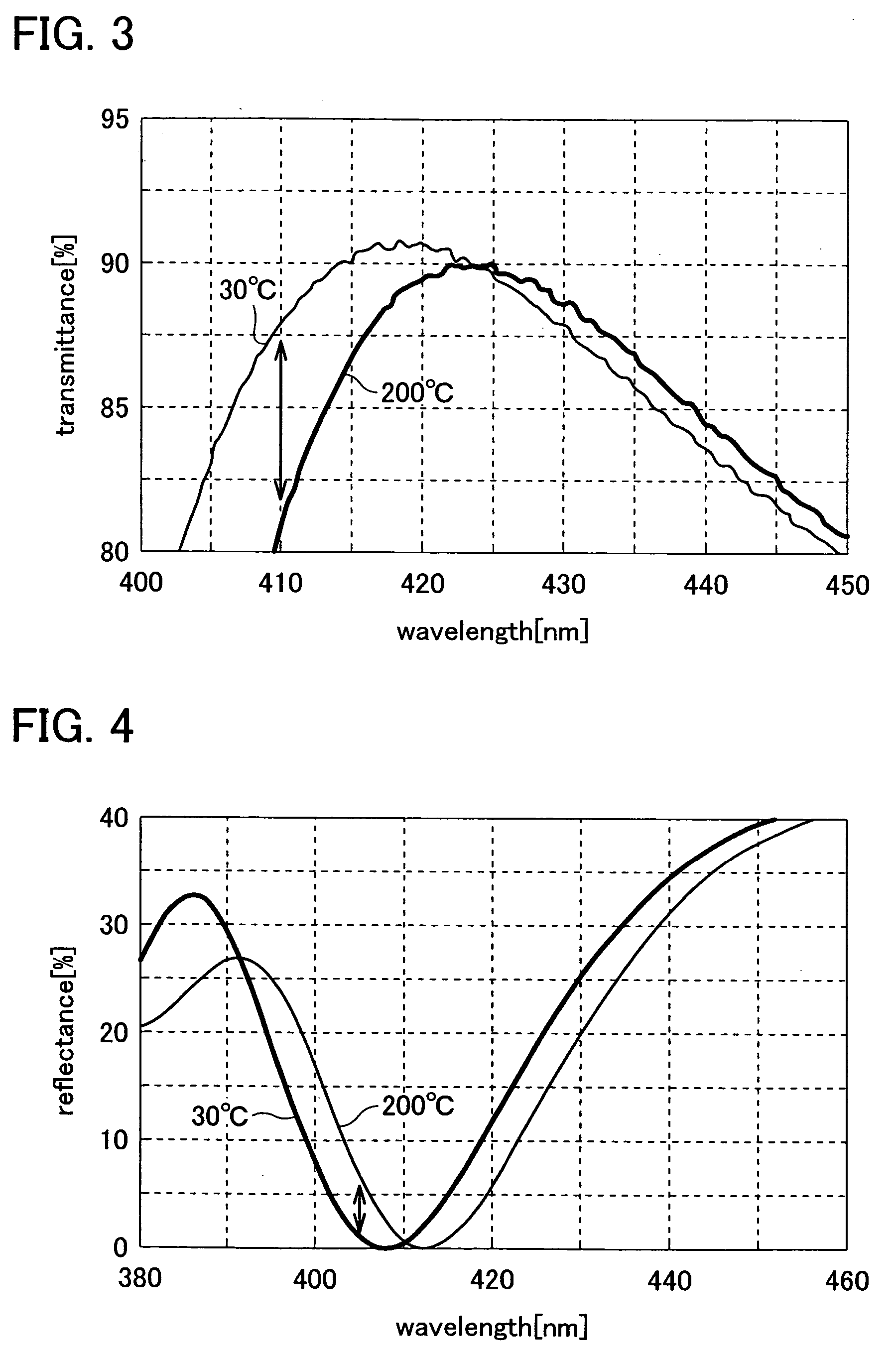Optical information recording medium, reproducting method using the same, and optical information processing device
a technology of optical information and recording medium, applied in the field of optical information recording medium, can solve the problems of insufficient reliability of information reproduction, na limitation, and inability to shorten the wavelength of the light source, so as to achieve effective change of complex refractive index, enhance the effect of light absorption in the optical multiple interference film, and effectively change the complex refractive index
- Summary
- Abstract
- Description
- Claims
- Application Information
AI Technical Summary
Benefits of technology
Problems solved by technology
Method used
Image
Examples
example 1
FIG. 2 is a cross section of an optical information recording medium 30 of Example 1 which is one of the examples of the present invention. This optical information recording medium 30 is a playback-only type. A substrate 31 is a polycarbonate substrate 12 cm in diameter and 1.1 mm thick. On one surface 31a of the substrate 31, information is recorded in advance in the form of phase pits. This surface 31a is the recording surface.
Next, on the surface 31a of the substrate 31, an Al film 30 nm thick is formed as a reflective film 34, by a magnetron sputtering method. On this reflective film 34, a Si film 50 nm thick is formed as a light-absorbing film 33, and a ZnO film 220 nm thick as a temperature-sensitive film 32 is further formed thereon. In this manner, a film stack (thin film section) 37 made up of, from the incident-light side, the temperature-sensitive film 32, the light-absorbing film 33, and the reflective film 34 is formed on the substrate 31.
As described above, the pr...
example 2
FIG. 7 is a cross section of an optical information recording medium 41 of Example 2, and this optical information recording medium 41 includes a two-layered film stack 38 in which a temperature-sensitive film 32 and a light-absorbing film 33 are deposited in this order from the incident-light side. Being identical with the optical information recording medium 30 of Example 1, the optical information recording medium 41 of Example 2 includes a substrate 31 made up of a polycarbonate plate which is 12 cm in diameter and 1.1 mm thick. On the recording surface 31a of the substrate 31, information is recorded in advance in the form of phase pits. On this recording surface 31a on which information has been recorded, an Si film 50 nm thick is formed as a light-absorbing film 33, by the magnetron sputtering identical with that in the optical information recording medium 30 of Example 1 and on the same sputtering conditions as those of the optical information recording medium 30 of Example ...
example 3
FIG. 8 is a cross section of an optical information recording medium 42 of Example 3, and this optical information recording medium 42 includes a three-layered film stack 39 in which a temperature-sensitive film 32, a light-absorbing film 33, and a transparent film 35 are deposited in this order from the incident-light side. Being identical with the optical information recording medium 30 of Example 1, the optical information recording medium 42 of Example 3 is arranged in the following manner: The transparent film 35 which is 20 nm thick and made up of an SiN film is formed on a recording surface 31a to which information is recorded, by the magnetron sputtering identical with that of Example 1. On this transparent film 35, a light-absorbing film 33 which is 50 nm thick and made up of an Si film is formed as in Example 1, and a temperature-sensitive film 32 which is 220 nm thick and made up of a ZnO film is further formed thereon. That is to say, in the optical information recording...
PUM
| Property | Measurement | Unit |
|---|---|---|
| wavelength distribution | aaaaa | aaaaa |
| wavelength distribution | aaaaa | aaaaa |
| wavelength | aaaaa | aaaaa |
Abstract
Description
Claims
Application Information
 Login to View More
Login to View More - R&D
- Intellectual Property
- Life Sciences
- Materials
- Tech Scout
- Unparalleled Data Quality
- Higher Quality Content
- 60% Fewer Hallucinations
Browse by: Latest US Patents, China's latest patents, Technical Efficacy Thesaurus, Application Domain, Technology Topic, Popular Technical Reports.
© 2025 PatSnap. All rights reserved.Legal|Privacy policy|Modern Slavery Act Transparency Statement|Sitemap|About US| Contact US: help@patsnap.com



